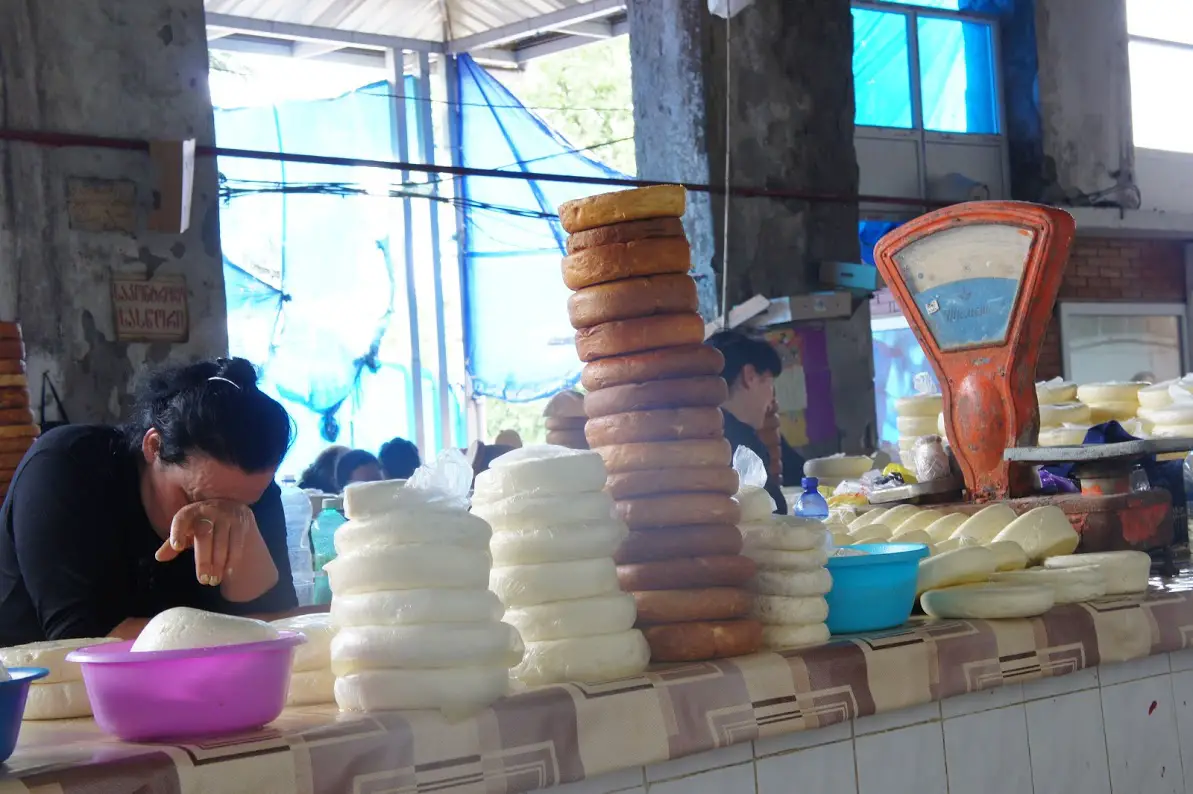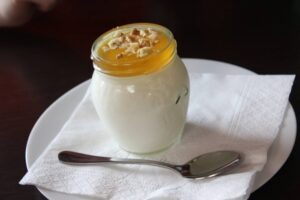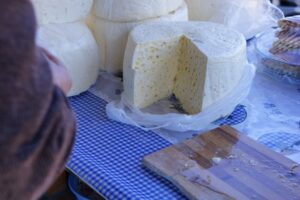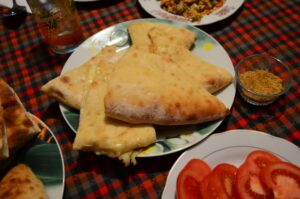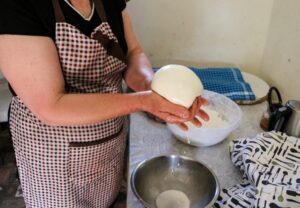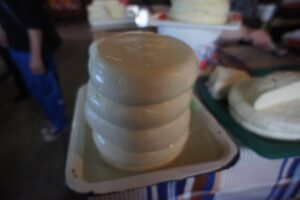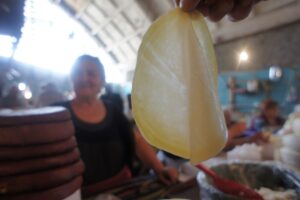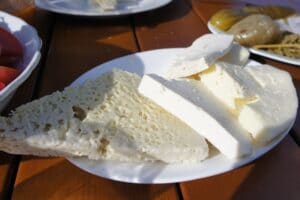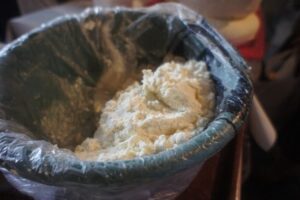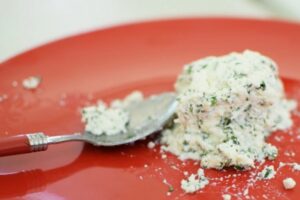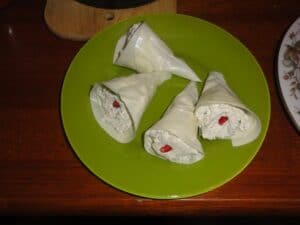Georgian cuisine, known for its unique flavor combinations, is also known for several unique dairy products. Like similar dairy products around the world, these originated from the same need to preserve the nutritional and caloric value of milk. With several local twists to the preparation process, however, including the use of “spontaneous starters” – or locally found bacterial cultures – these foods have become known as specific to the Caucasus Mountains.
One should know that Georgia, neighboring Armenia, and some other local cultures have ancient connections and that many of these foods are shared between them and are considered national foods for cultures other than Georgian as well.
In many of Georgia’s local markets, these can still be found prepared in small, handmade batches using traditional methods and fresh, local, organic, and free-range ingredients. This not only improves taste, but also is believed to be far better for the eater’s digestive health. To give a better idea of how dairy products play a part in Georgian cuisine, this article will introduce and explore the most commonly consumed dairy products which are considered Georgian national foods.
Matsoni
Matsoni literally translates to “to sour.” It is a traditional cultured milk product from the Caucasus and is famed for its beneficial impacts on the digestive system. Similar to yogurt, It has a thick and slightly jelly-like consistency, but once mixed or shaken the product loosens to form a thinner, drinkable consistency.
Matsoni is quite simple to make. Sheep milk is most traditional to use, although cow milk is most commonly used nowadays. Goat milk and buffalo milk are also acceptable. The milk is warmed and then lactococcus and lactobacillus delbrueckii bacterial cultures are added. These bacteria can survive the entire journey through the digestive system and are potent probiotics with positive health effects. The milk is kept warm for around 4 to 5 hours and then left to sour at room tempature.
Matsoni has many uses in Georgian culinary traditions. It is enjoyed as an accompaniment to bread (butter is relatively uncommon), particularly at breakfast. It can be made into soups, sauces, or marinades. It can also be mixed with fresh or dried fruits, honey, and/or walnuts and eaten as a desert.
Imeruli Cheese
Otherwise known as chkinti-kveli, Imeruli cheese is possibly the most popular cheese among Georgians. This cheese emanates from the Imeretian Region of Georgia and fosters a soft, yet slightly chewy texture, with a mild and somewhat sour flavor. Imeruli is often served as a side dish, or used as the stuffing for khatchapuri (particularly Imeruli khatchapuri).
This young cheese (“young” meaning matured for only a short amount of time) is produced by brining unheated milk curds in a saltwater solution and leaving to mature for 2 to 3 days. The brining process will stop the bacterial action and allow the cheesemaker to “time” the cheese to a specific acidity level which allows Imeruli to be a highly meltable cheese. However, a well prepared Imeruli cheese should have plenty of small holes, similar to feta cheese. This is an indication that the lactic acid within the cheese has been consumed by the bacteria, causing the release of carbon dioxide. There are only three ingredients used to make imeruli: milk, rennet, and salt.
Imeruli cheese also serves as the base for Sulguni.
Sulguni Cheese
Sulguni cheese, from the Svaneti Region of a Georgia, is a firm yet flexible white cheese. It is often compared to mozzarella, but is firmer. Sulguni is simple to make. The ingredients consist of Imeruli cheese (see above), whey (normally that which is left over from the imeruli preparation), cream, and salt. The ingredients are gently heated, combined, shaped into a ball and then drained and compressed. This causes the proteins in the cheese to align and a certain amount of the fat to break out. This is one reason that cream is used and why Georgian cheesemakers will often use techniques that will help maintain fat in the cheese structure. A fattier sulguni is generally considered a superior sulguni. The full process should leave the cheese denser and much more elastic, with a richer, saltier flavor.
Sulguni is also used as the stuffing for khatchapuri (stuffed cheese bread), khinkali (Georgian dumplings), and chvishtari (stuffed cornbread). When smoked, sulguni adopts a still-firmer consistency and is often served with ghomi – a thick porridge made from cornmeal, native to Samegrelo.
Sulguni also used as the basis of chechil.
Chechil Cheese

Having originated in the Adjara and Javakheti Regions of Georgia, Chechil cheese is a brined string cheese, celebrated for its stringy texture and salty taste. The production begins with pasteurizing cow’s or sheep’s milk, followed by curdling using an acidifying agent or rennet to separate curds from whey. The curds are then cut, heated, drained, and washed to eliminate excess whey and lactose. At this point, the resulting product can either be set into sulguni cheese or the process can diverge into making chechil.
To achieve chechil’s signature stringiness, the curds are next kneaded and stretched, after which they are braided or looped and submerged in a saltwater brine to enhance flavor and preservation. Depending on the desired outcome, the cheese may be aged, dried, or smoked. The final product is packaged, often vacuum-sealed, to maintain freshness until it’s ready to be enjoyed, typically as a snack paired with beer or used as an ingredient in salads and pasta dishes. Due to its flexibility, chechili tends to be presented in a variety of fashions, you can often find it woven, plaited, or sometimes shredded into thin strings.
Nadugi
Another dairy product popular among Georgians is often served as a side dish in a variety of ways: mixed with fresh mint, or wrapped in a thin lavash-like sleeve made from sulguni (see above). It also goes well with mchadi, a simple cornbread. Essentially nadugi is a farmers cheese, similar to Russian tvorog – a light, mild, creamy mass of curd. However, it also differs from Russian tvorog. Nadugi is made by heating whey, left over from prior cheesemaking, until the remaining curds separate and drift to the top of the liquid. These curds are then scooped up and this is the nadugi. Nadugi is naturally low in fat and high in protein. Find out how to make nadugi yourself here.
Tusheti Guda
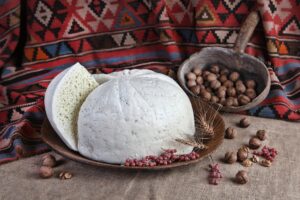
Georgian Guda cheese, which is most associated with the Tusheti region, is crafted using sheep’s or cow’s milk, or a blend of both. The process begins with collecting fresh, raw milk to preserve natural flavors and bacteria. The milk is then warmed and curdled using rennet or a natural coagulant, separating it into curds and whey.
What sets Guda apart is the next step: the curds are gathered and placed into cleaned and prepared sheepskin pouches. These pouches not only shape the cheese but also allow whey to drain while imparting a unique, earthy flavor. After being pressed to remove excess whey, the cheese is salted either directly or through brining, enhancing its taste and longevity. It may also be smoked, which also adds to the flavor and shelf life. Aging takes place in cool, ventilated conditions, allowing flavors to mature and the texture to firm.
This traditional method of using sheepskin pouches is integral to producing the authentic Guda cheese, celebrated for its tangy taste and crumbly texture, embodying the essence of Georgian cheese making heritage. Unfortunately, it is also holding the cheese back from wider manufacturing and export. The use of skins makes producing it on a large scale difficult as the sheepskins themselves are of limited size and producers must specially care for them to ensure quality.
Dambal’khatcho
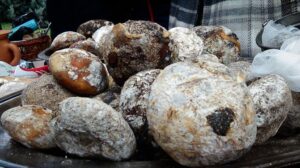
Similar in appearance, yet with a creamier flavor and smoother texture due to its higher fat content, is dambal’khatcho. This is quark, which is obtained by adding buttermilk to gently heated whole milk and then allowing the mixture to coagulate. The curds are then gathered and drained using a muslin cloth. The whey leftovers are often kept and used as an ingredient in baking or further cheese making.
The last part of the name, “katcho” might seem familiar because khatchapuri, the phenomenal Georgian cheese bread, contains the same root. “Katcho” simply refers to cheese. “Dambal’khatcho” means “moist cheese.”
These curds are not so interesting in and of themselves, as they are generally eaten a similar manner to how quark is eaten elsewhere. However, what is often done afterwards, such as storing them in special clay pots to allow the cheese to mildew and turn into dambal’khatcho, as shown above, results in a delicacy native to Georgia. Dambal’khacho is usually fried in butter before being served.
You’ll Also Love
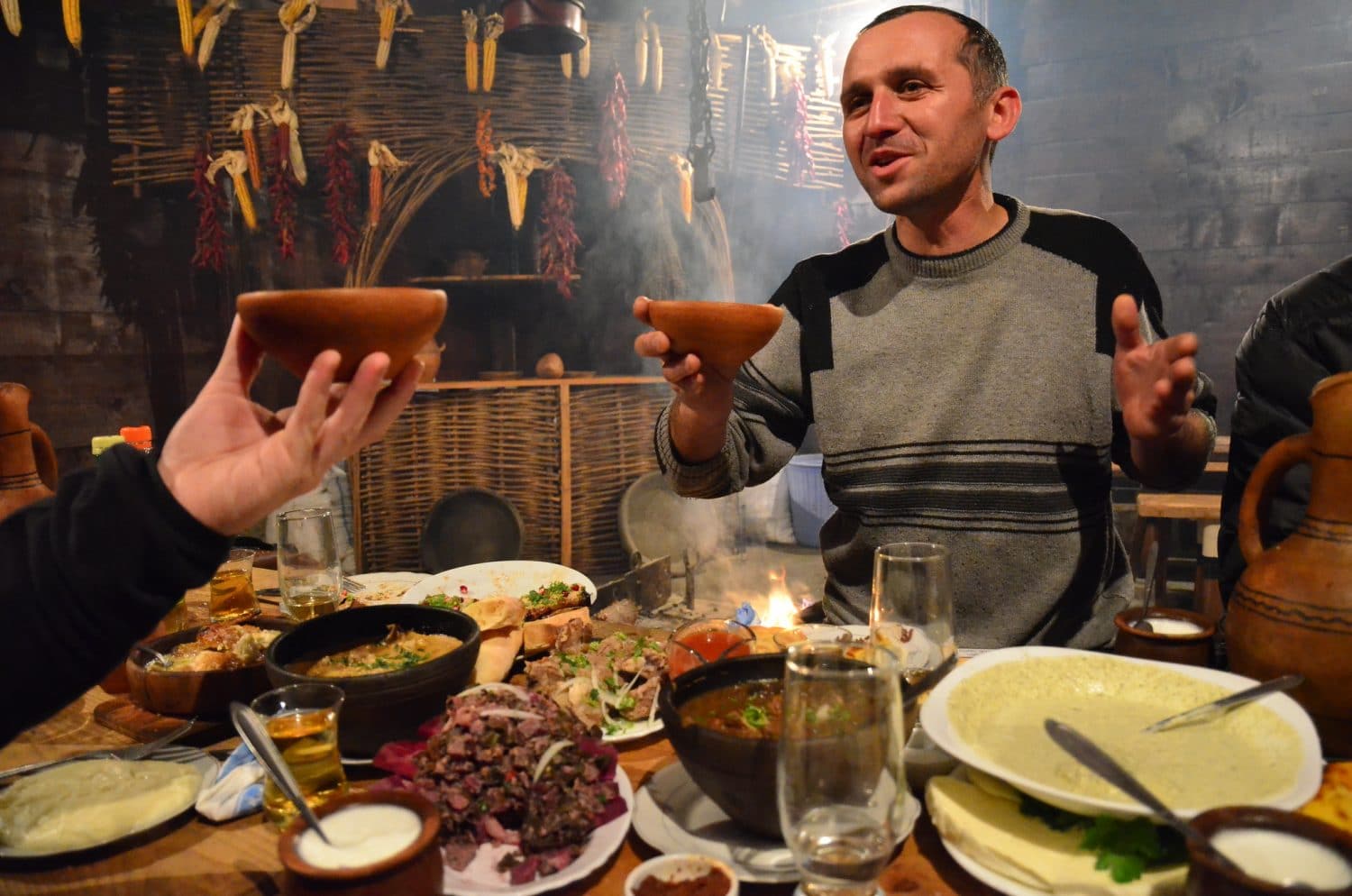
Georgian Nutrition: A Tasty Way to Good Health
As a nutritionist, food is often the driving factor of my travels. I love exploring the local and traditional cuisines which help shape the identity of a country. Georgian culture is strongly influenced by, and perhaps best known for, its unique and vibrant cuisine. Georgian cuisine in Georgia is packed with fresh and organic produce […]
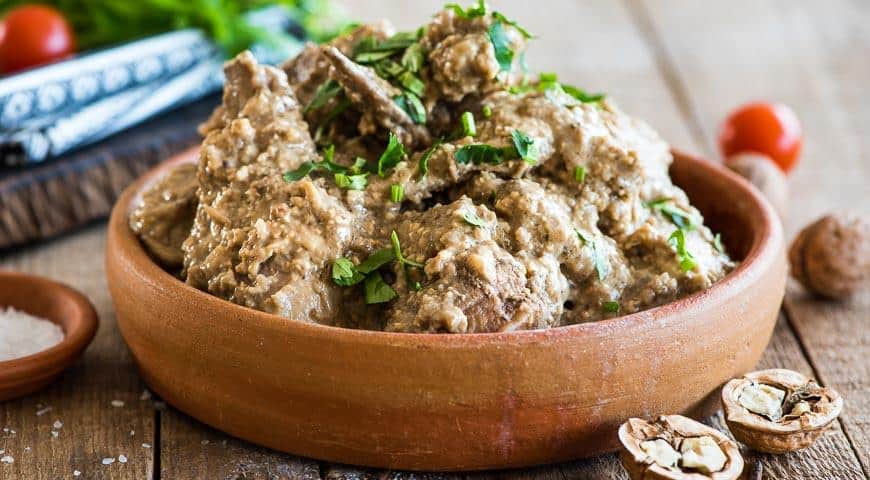
Satsivi: Georgian Poultry in Nut Sauce
Dr. Michael Denner: For a lot of Georgians, satsivi is… the essence of Georgian home cooking. It is intensely nostalgic, served as the main dish for celebrating the new year, at home, with friends and family gathered around the banquet table, the supra. SRAS: Dr. Michael Denner is a professor at Stetson’s Program in Russian, East […]
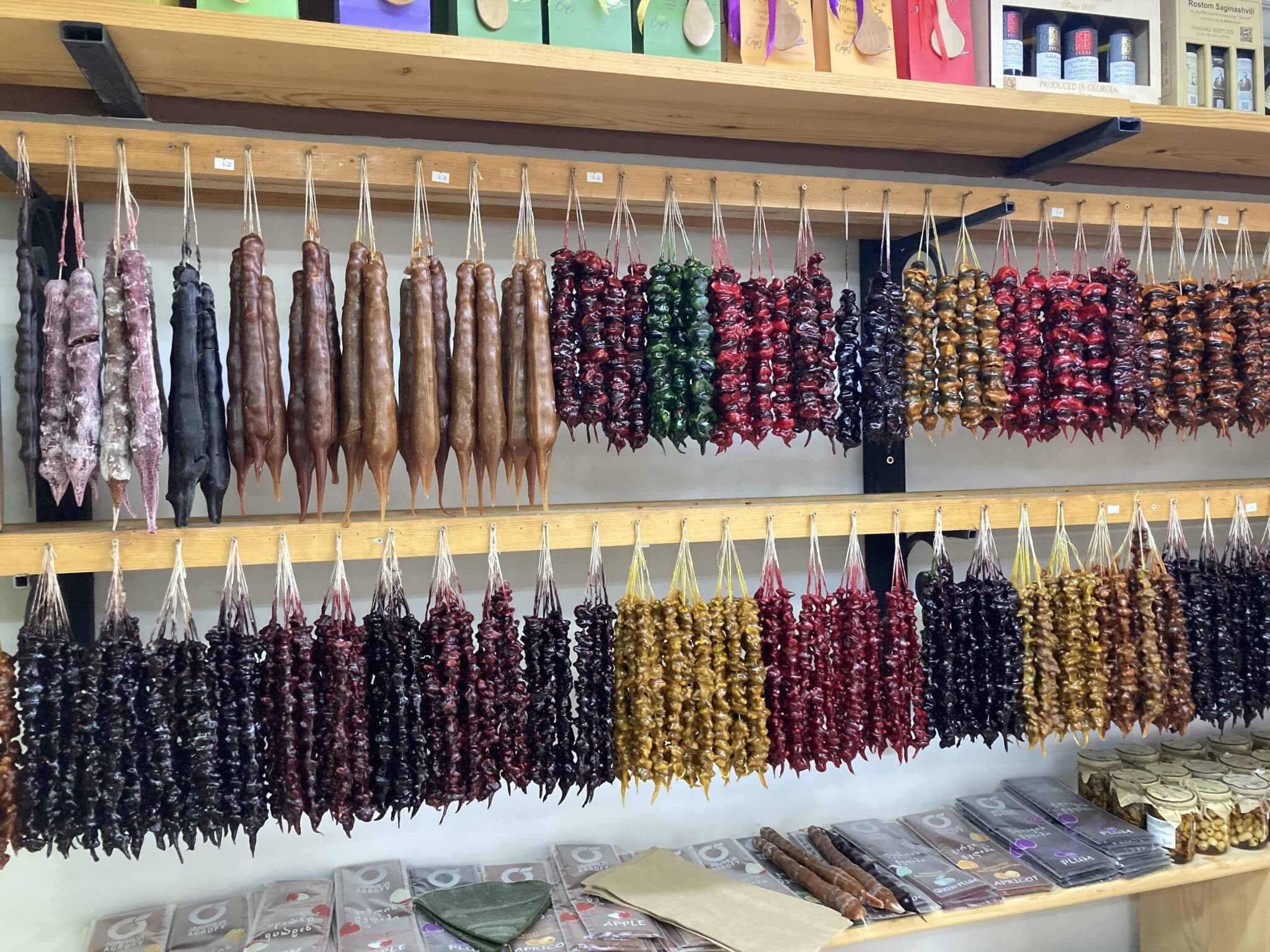
Churchkhela, Sharan, and Pelamushi: Desserts Off The Vine
Strolling through a marketplace in Georgia, you might be surprised to see the array of multicolored sausage-shaped candies hanging from the stalls. These are churchkhela, a traditional snack made by dipping strings of nuts into thickened fruit juice to create a chewy exterior. In Armenia, you’ll see “sausages” known locally as sharan that are very […]

Tarkhun: An Incredible, Natural Soda from Georgia
Tarkhun (тархун) is a carbonated soft drink made from tarragon leaves. The drink is known for its typically distinctive green color and is especially popular in Russia and the Caucasus. Tarkhun was first concocted, like most western sodas, by a pharmacist. Mitrofan Lagidze, a Georgian, first mixed carbonated water with his original tarragon syrup in […]
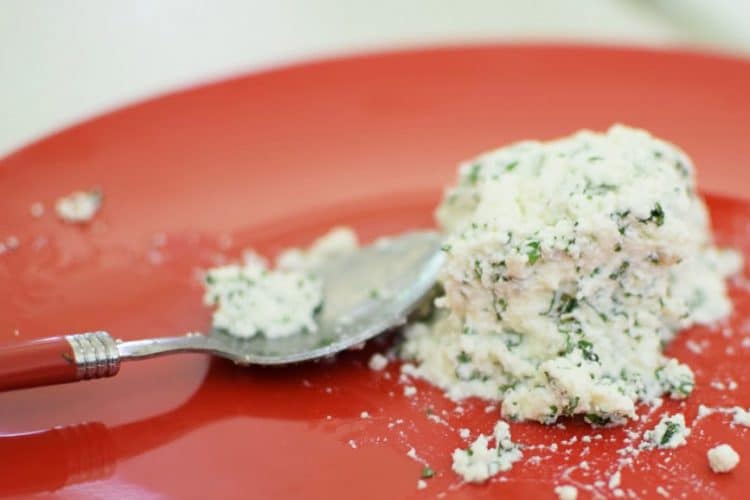
Nadugi: Never Too Much (Georgian) Cheese
Dr. Michael Denner: You can tell a lot about a cuisine and culture by the way they eat their milk… That’s the point I tried to make in our latest Georgian Cooking Club meeting, waving about a gallon of milk, sheathed in its translucent plastic carapace. My students were confused at first… Georgian Milk Milk. […]

